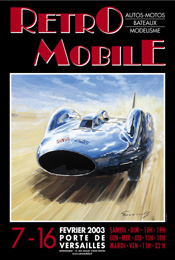The Year of all Records
In the history of Land Speed Records - which began already in the 19th century with
Camille Jenatzky to exceed 100 Km/h or 60 mph - there are many achievements and important
contributors. But two names stand out - Seagrave and Campbell. Major Henry Seagrove,
the winner of the 1923 French Grand Prix, was the first to go faster than 200 mph in 1927 with the Golden Arrow, Malcom Campbell
reached 300 mph in 1935 and his son Donald Campbell went faster than 400 mph
in 1964 with the famous Bluebird (Craig Breedlove even broke the 500 mph barrier the same year, and the 600 mph barrier in 1965 - but his vehicles were not wheel driven).
|
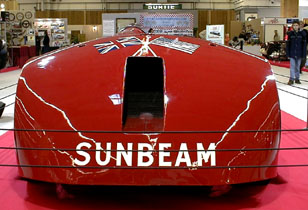
The 1000 horsepower Sunbeam from 1927 -
the first vehicle driving at a speed of 200 miles per hour. The power came from two V-12, 48 valve Matabele
airplane engines and the wheels were chain driven.
|
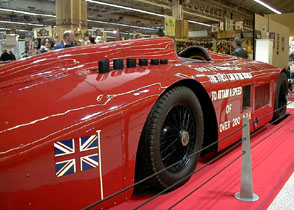
After reaching 200 mph on the beach of Daytona, Florida for the very first
time, Major Henry Seagrave had to steer the record car into the sea in order to slow it down.
|
The probably most recognizable record breaking car of all times is the 1929 Golden Arrow, utilizing
a 12-cylinder Napier Lion engine in W configuration with an output of 930 hp. Designed by
J.S. Irving, it was driven by Henry Seagrave at Daytona Beach, Florida to a new
record of 372 Km/h or 231 mph.
|
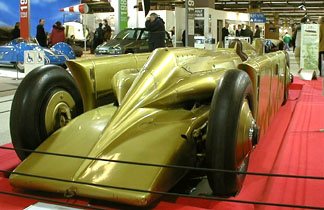
After the 1000 horsepower Sunbeam from 1927 -
which raised the bar to over 200 mph - the Golden Arrow was designed to regain the record back
from Malcom Campbell.
|
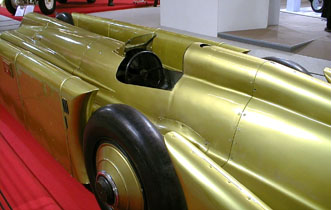
The workplace of Henry Seagrave - safety features
of any kind were completely unknown in 1929.
|
This years' poster car - the Bluebird CN7 Proteus from 1963 and one of two
Campbell record cars. Donald Campbell followed sucessfully in the foot steps of his
father Malcom Campbell, breaking several World Speed Records himself.
|
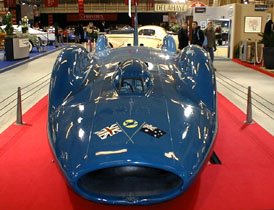
The appearance of a jet fighter on wheels and powered by a
Bristol-Siddeley Proteus 4100 hp gas turbine engine - enough to set the record of 649 Km/h or 403 mph
at Lake Eyre, Australia.
|
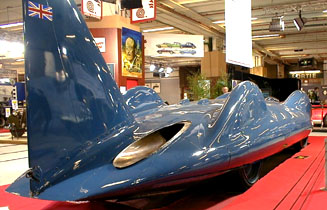
The fintail was added after a disastrous crash in
Bonneville, Utah in 1960. It took another 4 years and over Ł1 million to set the record straight.
|
The 1954 Renault Etoile Filante was an experimental vehicle, powered by a turbine instead of a
piston engine. Driver Jean Hebert set a speed record of 309 Kmh at the Bonneville Salt Flats,
which at that time was the fastest speed for a turbine powered vehicle.
|
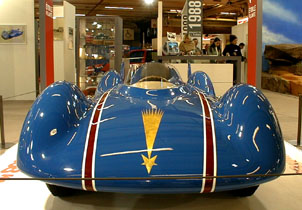
Aerodynamical shape and composite materials made the
Etoile Filante or Shooting Star a record breaking design.
|

With a weight of 950 kg and a powerplant producing 270 hp at
28,000 rpm, this Shooting Star ran on pure kerosine.
|
The Citroën SM Bonneville had it's first showing in Europe at this year's RÉTROMOBILE.
Prepared by Jerry & Sylvia Hathaway from California for pure speed in 1980, it reached
206.446 mph - or 332.242 Km/h - at the Bonneville Salt Flats - record for a front wheel driven vehicle.
|
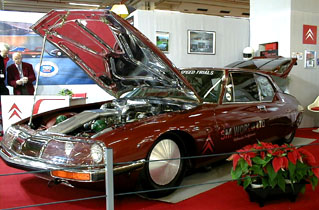
Covered wheels, twin turbo chargers
on the standard Maserati engine, an aerodynamic body by default, and you have the fastest front wheel driven vehicle in the world.
|
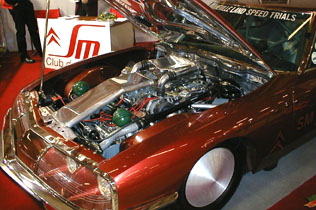
Most of the Citroën SM
mechanics remained original - the 3 litre engine seemed to have enough potential to make both
Jerry and Sylvia Hathaway members of the 200 mph club.
|
|

